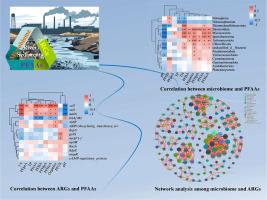全氟烷基酸污染河流沉积物微生物群落响应及耐药基因的宏基因组研究
IF 6.3
2区 环境科学与生态学
Q1 ENVIRONMENTAL SCIENCES
引用次数: 0
摘要
液固相转移促进了全氟烷基酸(PFAAs)与河流沉积物微生物系统的相互作用,从而可能影响底栖生物环境中抗生素抗性基因(ARGs)的环境行为。对从中国最大的含氟聚合物生产设施接收水中收集的沉积物进行了分析,以研究PFAAs对微生物群落和ARG剖面的影响。PFAAs的主要来源是全氟辛酸和全氟丁酸,其在受工业废水影响的下游表层沉积物中的比例(86.9% - 93.4%)显著高于上游样品(53.3%)。在下游地区,高浓度PFAAs的存在导致微生物多样性和丰富度降低。在沉积物样品中鉴定出144种ARG亚型,其中包括3种高风险亚型(bacA、aac(6′)-I和aadA)。氟化学品废水的排放也导致ARG亚型多样性的减少。PFAAs对沉积物中ARGs的分布有显著影响。PFAAs和水质参数(如pH和总磷)是沉积物中微生物群落组成的关键驱动因素。PFAAs对微生物群落的调控可能是这些化合物影响ARG谱的重要途径。本文章由计算机程序翻译,如有差异,请以英文原文为准。

Metagenomic investigations of microbial community response and antibiotic resistance genes in river sediments polluted by perfluoroalkyl acids
Liquid-solid phase transfer promotes the interaction of perfluoroalkyl acids (PFAAs) with the microbial system of river sediments, which may affect the environmental behavior of antibiotic resistance genes (ARGs) contained in benthic environments. Sediments collected from the receiving water of the largest fluoropolymer production facility in China were analyzed to investigate the impact of PFAAs on microbial communities and ARG profiles. The main contributors to the PFAAs were perfluorooctanoic acid and perfluorobutanoic acid, whose proportions (86.9 %-93.4 %) in the downstream surface sediments affected by industrial effluents were significantly higher than in the corresponding upstream samples (53.3 %). A reduction in microbial diversity and richness was observed in the presence of high concentrations of PFAAs at the downstream sites. 144 ARG subtypes, including three high-risk subtypes (bacA, aac (6′)-I and aadA), were identified in sediment samples. The discharge of fluorochemical effluents also results in a reduction of ARG diversity at subtype level. PFAAs exert a pronounced influence on the profile of ARGs in sediment. PFAAs and water quality parameters (e.g. pH and total phosphorus) were key drivers of the microbial community composition in the sediment. The regulation of microbial communities by PFAAs may represent an important pathway by which these compounds affect ARG profiles.
求助全文
通过发布文献求助,成功后即可免费获取论文全文。
去求助
来源期刊

Journal of Environmental Sciences-china
环境科学-环境科学
CiteScore
13.70
自引率
0.00%
发文量
6354
审稿时长
2.6 months
期刊介绍:
The Journal of Environmental Sciences is an international journal started in 1989. The journal is devoted to publish original, peer-reviewed research papers on main aspects of environmental sciences, such as environmental chemistry, environmental biology, ecology, geosciences and environmental physics. Appropriate subjects include basic and applied research on atmospheric, terrestrial and aquatic environments, pollution control and abatement technology, conservation of natural resources, environmental health and toxicology. Announcements of international environmental science meetings and other recent information are also included.
 求助内容:
求助内容: 应助结果提醒方式:
应助结果提醒方式:


